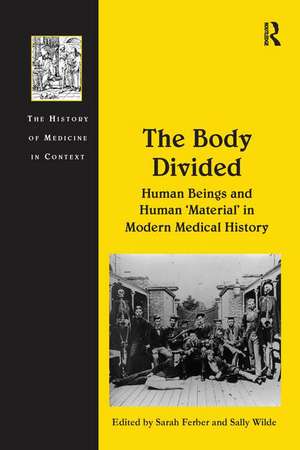The Body Divided: Human Beings and Human 'Material' in Modern Medical History: The History of Medicine in Context
Autor Sally Wilde Editat de Sarah Ferberen Limba Engleză Paperback – 9 sep 2016
| Toate formatele și edițiile | Preț | Express |
|---|---|---|
| Paperback (1) | 469.34 lei 43-57 zile | |
| Taylor & Francis – 9 sep 2016 | 469.34 lei 43-57 zile | |
| Hardback (1) | 1115.51 lei 43-57 zile | |
| Taylor & Francis – 28 ian 2012 | 1115.51 lei 43-57 zile |
Din seria The History of Medicine in Context
-
 Preț: 311.70 lei
Preț: 311.70 lei -
 Preț: 311.41 lei
Preț: 311.41 lei -
 Preț: 325.55 lei
Preț: 325.55 lei -
 Preț: 386.77 lei
Preț: 386.77 lei - 13%
 Preț: 338.33 lei
Preț: 338.33 lei -
 Preț: 489.26 lei
Preț: 489.26 lei -
 Preț: 492.53 lei
Preț: 492.53 lei -
 Preț: 469.34 lei
Preț: 469.34 lei - 18%
 Preț: 1000.27 lei
Preț: 1000.27 lei -
 Preț: 323.23 lei
Preț: 323.23 lei - 25%
 Preț: 824.80 lei
Preț: 824.80 lei - 18%
 Preț: 1054.71 lei
Preț: 1054.71 lei -
 Preț: 489.26 lei
Preț: 489.26 lei - 17%
 Preț: 819.35 lei
Preț: 819.35 lei - 22%
 Preț: 324.16 lei
Preț: 324.16 lei -
 Preț: 497.92 lei
Preț: 497.92 lei - 31%
 Preț: 764.20 lei
Preț: 764.20 lei -
 Preț: 469.34 lei
Preț: 469.34 lei -
 Preț: 486.76 lei
Preț: 486.76 lei - 25%
 Preț: 823.44 lei
Preț: 823.44 lei - 5%
 Preț: 464.79 lei
Preț: 464.79 lei - 18%
 Preț: 1009.74 lei
Preț: 1009.74 lei - 18%
 Preț: 1054.71 lei
Preț: 1054.71 lei - 17%
 Preț: 346.02 lei
Preț: 346.02 lei - 5%
 Preț: 1158.84 lei
Preț: 1158.84 lei -
 Preț: 489.26 lei
Preț: 489.26 lei - 18%
 Preț: 1113.12 lei
Preț: 1113.12 lei - 18%
 Preț: 1055.51 lei
Preț: 1055.51 lei -
 Preț: 469.34 lei
Preț: 469.34 lei - 26%
 Preț: 765.04 lei
Preț: 765.04 lei -
 Preț: 489.26 lei
Preț: 489.26 lei - 18%
 Preț: 1008.17 lei
Preț: 1008.17 lei - 18%
 Preț: 1006.77 lei
Preț: 1006.77 lei - 18%
 Preț: 1054.71 lei
Preț: 1054.71 lei
Preț: 469.34 lei
Nou
Puncte Express: 704
Preț estimativ în valută:
89.81€ • 94.00$ • 74.75£
89.81€ • 94.00$ • 74.75£
Carte tipărită la comandă
Livrare economică 31 martie-14 aprilie
Preluare comenzi: 021 569.72.76
Specificații
ISBN-13: 9781138246829
ISBN-10: 1138246824
Pagini: 264
Dimensiuni: 156 x 234 x 14 mm
Greutate: 0.45 kg
Ediția:1
Editura: Taylor & Francis
Colecția Routledge
Seria The History of Medicine in Context
Locul publicării:Oxford, United Kingdom
ISBN-10: 1138246824
Pagini: 264
Dimensiuni: 156 x 234 x 14 mm
Greutate: 0.45 kg
Ediția:1
Editura: Taylor & Francis
Colecția Routledge
Seria The History of Medicine in Context
Locul publicării:Oxford, United Kingdom
Cuprins
Contents: The body divided in time and place: an introductory essay, Sarah Ferber and Sally Wilde; A body buried is a body wasted: the spoils of human dissection, Helen MacDonald; Cadavers and the social dimension of dissection, Ross L. Jones; Dissection, Anatomy Acts, and the appropriation of bodies in 19th-century Australia: 'the government's brains' and the benevolent asylum, Susan K. Martin; Bodies of evidence: dissecting madness in colonial Victoria (Australia), Dolly MacKinnon; A judicious collector: Edward Charles Stirling and the procurement of Aboriginal bodily remains in South Australia, c.1880-1912, Paul Turnbull; The leprosy-affected body as a commodity: autonomy and compensation, Jo Robertson; Gifts, commodities and the demand for organ transplants, Sally Wilde; Science fiction, cultural knowledge and rationality: how stem cell researchers talk about reproductive cloning, Nicola J. Marks; Inventing the healthy body: the use of popular medical disclosures in public anatomical exhibitions, Elizabeth Stephens; Epilogue, Leo Brown; Index.
Notă biografică
Sarah Ferber is Associate Professor of History at the University of Wollongong, Australia, and Sally Wilde is Honorary Research Fellow at the University of Queensland, Australia.
Recenzii
'... an absorbing study of the issues and attitudes surrounding medical uses of the human body... often disturbing or challenging, and invariably fascinating.' Historical Records of Australian Science 'This thought-provoking collection lives up to the promise of its title. The body is, divided, literally, into its constituent parts for medical purposes. We are divided on how to preserve its integrity for human beings while harvesting its material for, well, other human beings. We are conscious, in the modern world, of the need to reaffirm equally the dignity of all bodies, and we are equally conscious of how firmly inequality is embodied in past historical practices. This collection has excellent notes and bibliography for each article, making it a valuable resource for scholars. It will be of interest to any readers who dwell within, own, use and analyse bodies.' Social History of Medicine ’...the collection will be of interest to analysts of the material culture of medicine, and to scholars who aim to develop historically grounded perspectives on the ethics and politics of modern medicine.’ Reviews in Australian Studies ’...this is a collection of interesting and thought-provoking reads.’ ISIS
Descriere
Bodies and body parts of the dead have long been considered valuable material for use in medical science. They have been dissected, autopsied, investigated, harvested for research and therapeutic purposes, collected to turn into museum and other specimens, and then displayed, disposed of, and exchanged. This book examines the history of such activities, from the early nineteenth century through to the present, in hospitals, universities, workhouses and lunatic asylums in England and Australia. A series of case studies reveals the changing scientific, economic and emotional value of corpses and their contested place in medical science.
